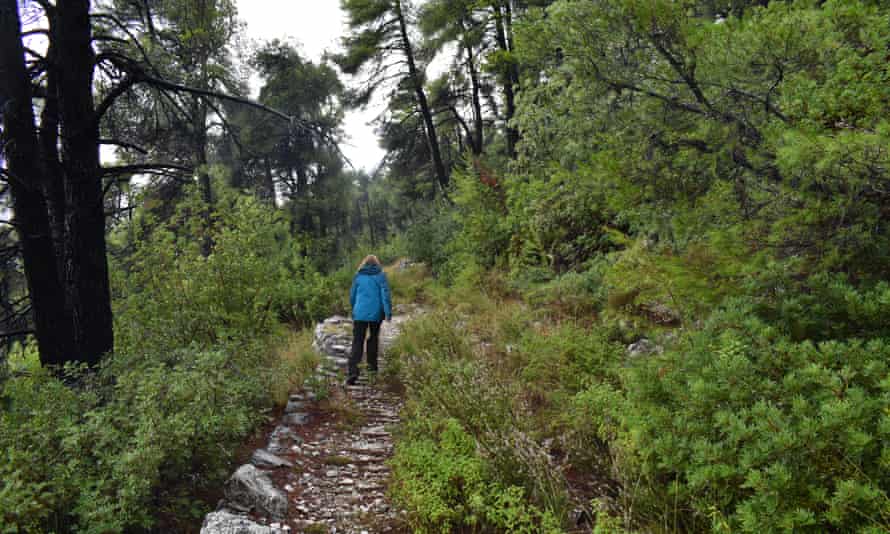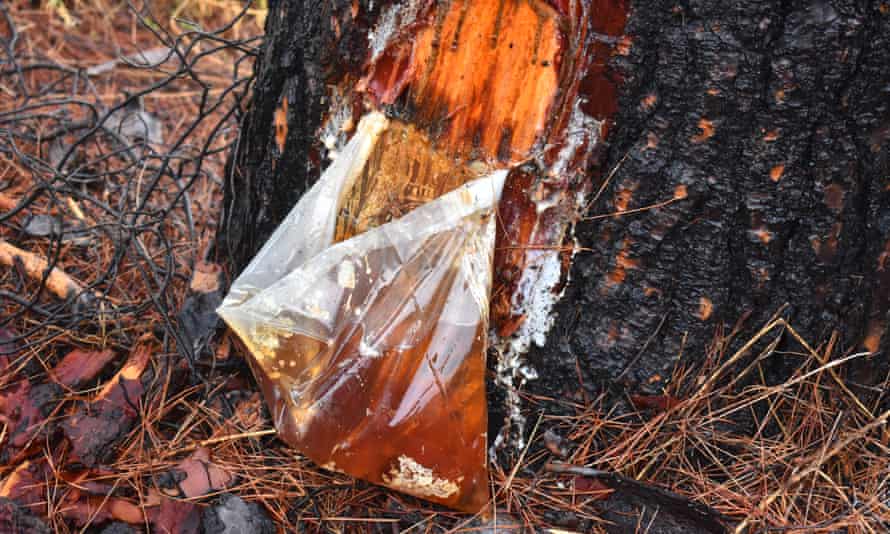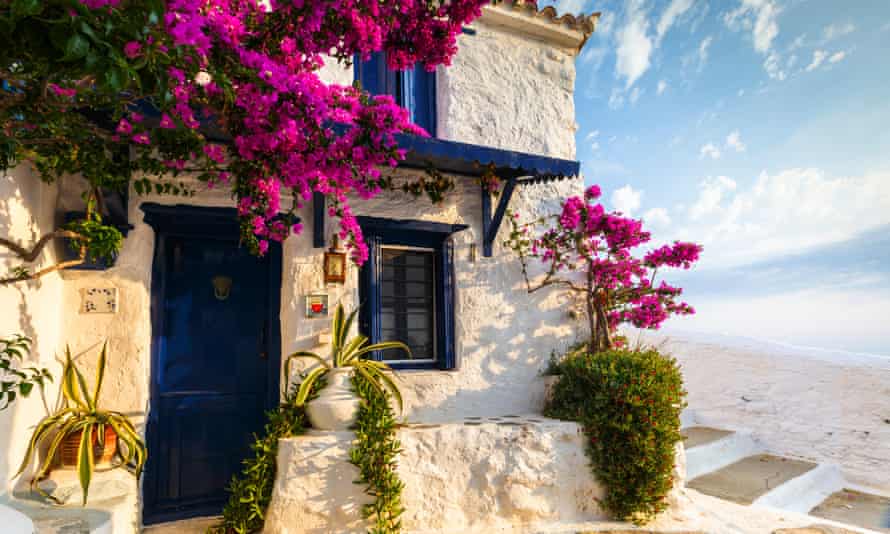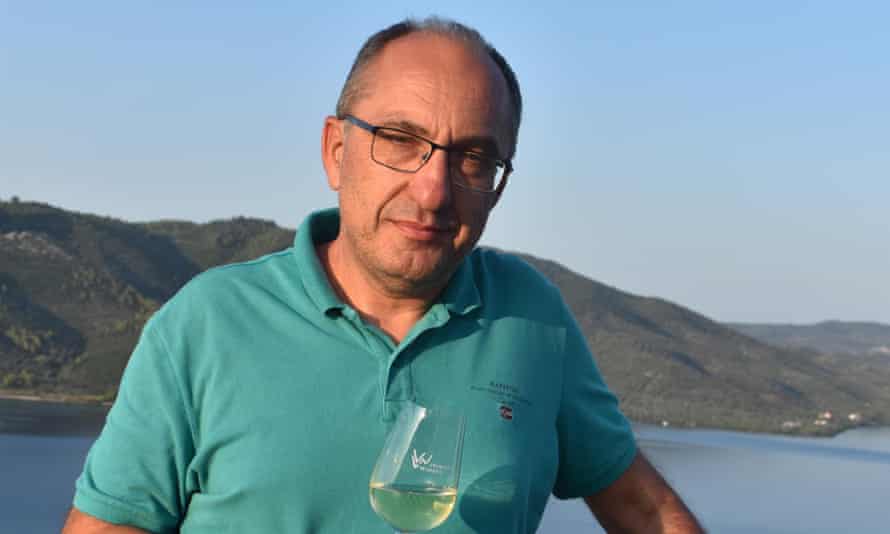We’re high in the mountains above Skopelos town and there’s not a single Mamma Mia! fan in sight. A warm breeze stirs the trees, filling the air with the citric scent of pine needles as we follow the Retsina Trail, one of several ancient cobbled paths (known as calderimi) that were used by the island’s resin collectors up until the 1990s when demand for the sticky substance declined.
It’s early October and spike-armoured chestnuts scrunch beneath our feet as we hike through dense forest covering the spine of this lush Sporades island, just an hour’s ferry from Skiathos. Apart from the chestnuts and the occasional cluster of tiny rain-starved blackberries, there’s little else to tell us that it’s autumn; with temperatures soaring to 30C by midday we appreciate the forest’s dappled shade. As we walk, Heather Parsons, owner of hiking company Skopelos Trails, shows me how the resin collectors would tap the pines by peeling back a small strip of bark, applying a paste that stimulates the flow of sap, then attaching a bag to catch the sticky substance as it slowly leaked from the tree. Several tons of resin would then be carried – via this trail – to Skopelos on the island’s north-east coast, where it would be shipped off to the mainland for use in paints, solvents and cosmetics, and for making Greece’s iconic retsina wine.

Cresting a steep section of the cobbled path, we pause to admire the view: on every side the mountains are covered in the blue-green fur of Aleppo pines. From a distance it’s so dense it looks like tropical vegetation and I have the odd sensation that we’ve swapped the Sporades for somewhere in the Caribbean.
The calderimi loops ahead of us, the cobbles slotted closely together like pieces of a stone-age jigsaw puzzle. Heather has devoted half a lifetime to saving these sadly neglected trails from the encroaching undergrowth. Since arriving on Skopelos some 30 years ago the British-born tour guide has spent all her spare time cutting back brambles, removing shrubs that grow between the cobbles and speaking with locals in order to seek out calderimi that would otherwise remain buried. Initially she worked on her own, but now she has a handful of volunteers who help her in her Herculean task.
“The state isn’t interested in protecting them and my only funding is from visitor’s donations, but they’re just so beautiful I can’t bear to abandon them,” she says, stooping to remove a clump of sow thistle growing across our path.

“When I was first here people were still taking the resin and shipping it – the resin-makers lived in small cottages and used tins to collect resin. They wore a sort of bib and they’d pour resin into the bib beneath their chin and then empty it into barrels,” she tells me.
Heather has written a detailed guidebook with information about the half-dozen trails she has uncovered so far. “People can do the walks on their own, but I also offer guided hikes,” she says. “At almost 12 kilometres, the Retsina Trail is the longest, so it’s probably worth having a guide for this one,” she adds.
We stop once more to admire views over to Evia. Wrapped in candyfloss clouds, the mythical island where the Titans once roamed floats mirage-like above the Aegean’s cobalt waters. Heather points out a squat structure made of bricks beneath us in a field. “That’s a prune oven,” she tells me. “One of Skopelos’s nicknames is ‘island of the plums’ because of this fruit which is grown here. They dry them to make prunes and use them in lots of delicious local recipes, like xoirino me damaskina – pork with prunes – or avgato, a sort of plum marmalade,” she tells me.

We hike on along the winding path – apart from the occasional Balkan wall lizard sunning itself on the calderimi cobbles ahead of us, the trail – which takes us across the island’s mountainous spine from south-east to south-west – is deserted. It’s almost a shock some five hours later to encounter tavernas and tourists once more near Milia, one of the long, sandy beaches that starred in Mamma Mia!
Hot and hungry, we end our hike at Linarakia, a beach taverna overlooking the mirror-clear waters of Panormos Bay where the owner’s daughter Eleni Stamatis shows us pictures of her grandfather who once lived in this small shack and collected resin in the surrounding forests to make retsina.
Once the turpentine-flavoured backdrop to every Greek holiday, retsina was accidentally invented back in 2000BC when ancient Greeks used resin to seal their porous amphorae and fell in love with the linseed oil and lime-peel flavours it gave to the wine. Later, retsina was produced using the same techniques as for white or rosé wine, with Aleppo pine resin added during fermentation. From the 1960s onwards, however, when increased demand led to a spike in production, more and more resin was added, not to conserve the wine but to mask its flaws.

As the quality of retsina declined, so did its popularity. Over the past decade, however, as vintners experiment with different grape varietals and cut down the amount of resin added to the wine during fermentation, Greece’s best-known resinous wine has been reinvented – often with spectacular results.
Although the calderimi still exist, resin is no longer tapped here in Skopelos and today retsina is brought in from elsewhere. Across on Evia, however, Giannis Vriniotis, owner of North Evia’s only accredited winery, is planning to start making his own, sourcing the Aleppo pine sap locally. Evia is one of the three Greek regions – along with Attica and Viotia – to have a Protected Designation of Origin (PDO), the equivalent of France’s appellation d’origine contrôlée, for retsina.
Since retsina is rarely aged, Vriniotis hopes to uncork the first bottle some time next year. “It’s time to bring retsina back to its birthplace,” he tells me. “It’s had a bad name for decades but now there are a lot of winemakers who are making crisp and refreshing retsinas that are excellent served with our Greek ladera – olive oil-cooked vegetables – and many other dishes that are traditionally difficult to pair with wines.”
One of the first producers to experiment was Stelios Kechris in Thessaloniki, whose retsinas are now served in some of the country’s best restaurants. Other new-age retsina producers include Vassilis Papagiannakos, third-generation owner of the Papagiannakos winery on the Greek mainland opposite southern Evia, and Aristos Spanos, co-owner of Tetramythos winery near Diakopto in the Peloponnese.
Before I leave Greece I’m keen to try a modern-day retsina – so back in Athens at Oinoscent, one of the city’s best wine bars, I order a glass of Kechris’ Tear of the Pine to accompany a dish of chef Christos Boukas’s semi-cured mackerel. Fresh and light-bodied, it’s a long way from the drink I remember fuelling many an evening on island-hopping holidays in the 90s. Perhaps retsina will have its day again after all.





